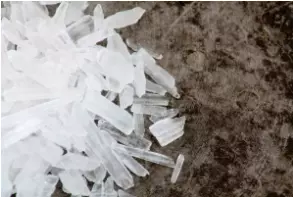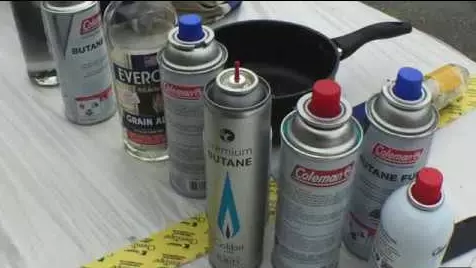Methamphetamine is a powerful and addictive central nervous system (CNS) stimulant chemically similar to amphetamine but has more negative side effects on the central nervous system. It is a bitter-tasting white powder with no odor that dissolves quickly in water or alcohol.
The US Drug Enforcement Agency (DEA) classifies methamphetamine as a Schedule II stimulant, which means it has a high potential for misuse and may only be obtained lawfully with a prescription.
When abused, methamphetamine is also known by many street names, including meth, speed, chalk, ice, shards, glass, Tik, and Tina. Methamphetamine is commonly smoked, snorted, ingested, or injected when abused.
The Crank or Meth Epidemic
Speed has been present since the 1800s when it was initially produced as asthma medication and then used as a military crutch under Hitler’s rule. He sought a chemical that would make his troops slim, mean, and capable of fighting nonstop with little or no rest or nutrition.

His chemists honed the formula, later commercialized as a diet supplement and metabolism booster.
When it became clear that there was a market for it, it was sold underground to biker gangs beginning with the Hell’s Angels in Los Angeles.
It swiftly spread across the country as a ‘crank.’
Also, in the early 1990s, making speed from Vicks inhalers was common before Desoxyn was removed from Vicks Benzedrex inhalers, i.e., Vicks Benzedrex inhalers were used to manufacture “bathtub crank.”
Phenyl-2-propanone (P2P) was recovered from Kodak film chemicals for phenethylamine synthesis in the 1970s and 1980s, along with red phosphorous, Sudafed, Red Devil lye, kerosene, and black iodine, purchased from horse farmers for use in medicating hooves, particularly from the Amish population.
Stopping the manufacture of meth/crank, as well as the desire to use it, is becoming nearly impossible. When precursor medications like Sudafed are outlawed or restricted, the cooks relocate the drug’s manufacturing to another country.
When the authorities in that country recognize what has happened, the drug lords relocate the operation to Asia or Europe. The finished product is then shipped back to the countries that have fought so hard to eliminate it in the first place.
What is a Bathtub Crank?
Crank is an altered form of methamphetamine. It is referred regarded as “poor man’s meth.” It is frequently combined with other drugs and substances, making it more deadly and volatile than crystal methamphetamine. Keep in mind that crystal meth is also harmful.

Crank is more damaging because users have no idea what is in it.
Taking a crank entails numerous dangers and risks, and the drug is used in the same way as meth.
The addicts can inject, smoke, and snort the concoction. Some consume the substance.
After administering the drug, its compounds enter the circulation and travel to the brain and CNS.
It generates a euphoric high that drives addicts to seek it out again and again.
Because the crank contains additional compounds, it lingers in the user’s system longer, causing injury and damage. Overdosing is also a significant problem because it is hard to determine the correct dose. Meth addicts should avoid injecting the drug because the risks are too substantial.
Why you should avoid Crank
Avoid crank and any drugs because it has the following adverse effects:
- Hyperthermia
- Dental problems
- Speech impairment
- Body aches and pains
- Irrational sense of time and place
- Risky behaviors and skewed judgment
- Anxiety, nervous hysteria, and paranoia
- Respiratory issues and rapid breathing
- Loss of Appetite and significant weight loss
- Hypertension, heart attacks, and rapid heartbeat
How to Make Bathtub Crank
It is worth noting that in the United States, the crank is primarily produced in large labs, with a few modest home labs thrown in for good measure. The majority of users prepare the crank for themselves to maintain their habits.
The issue is that most of these inexperienced cooks may not know how to do it properly. For every pound of meth cooked, over 2.7 kg of hazardous stuff is created.
However, this information or walk-in bathtub cost does not deter crystal meth addicts from manufacturing sloppy batches of seething, smelly, poisonous speed in poorly ventilated areas.
Houses used as meth labs are frequently uninhabitable afterward. Typically, when cities and states engage in meth lab busts, they don’t bother seizing the property because no one in their right mind would buy it at an auction, even at a severe discount.
The small meth labs can operate in the porcelain bathtub, especially the popular 58-inch bathtub in suburban homes, motel rooms, car trunks, campgrounds, and even in the wilderness.
Water contamination and the death of adjacent vegetation are expected outcomes of outdoor operations. Large-scale labs are frequently found within abandoned barns or buildings built mainly to produce meth on a factory line.
Making bathtub crank and recipes
Ephedrine or pseudoephedrine also referred to as the peanut butter crank recipe, are the significant components in bathtub crank.

If the cook doesn’t have them in their purest form, they will need to separate them from any medications or tablets that include them.
Typically, this is accomplished by first combining the drugs with a solvent and then filtering the solution at low temperatures to separate and remove the inert tablet material.
The pure form is then combined with red phosphorous and hydrogen chloride (HCL).
The operative will then filter the red phosphorous, and the residual acid will be neutralized by adding a dye solution.
Next, they add another chemical to bond the meth, after which the liquid meth could be drained. The liquid meth would next be passed through a hydrogen chloride gas generator, resulting in a crystalline hydrochloride salt.
The cook would then strain it through a filter before drying the remaining meth. Meth users consume the dried material. It’s important to note that this procedure can take two days.
Production methods
In a large production, the most common ingredients are ephedrine (or pseudoephedrine), iodine, and red phosphorus. In this hydriodic acid/red phosphorus process, the needed hydriodic acid is made by reacting iodine in water with red phosphorus.
The d-methamphetamine produced by this approach is of excellent quality. The cold cook step-by-step method involved ephedrine, iodine, and red phosphorus. It was confined to small production batches because the chemicals are placed in a hot environment, such as direct sunshine, rather than heated.
In the 1980s and 1990s, Lithium batteries were utilized in the cold cook method of producing this horrible concoction. There were addicts or ‘tweakers’ in constant agitation weeks after their last hit from extended use; the neurological and physical impacts on the body are astounding.
“Faces of Meth” photographs went viral, and they were a genuine depiction of how debilitating this drug can be on the body, with enormous body sores, cracked lips and fingernails, and deeply sunken orbs.
Parting Shot
Bathtub Crank is a dangerous substance in the first place, and producing it at home in the porcelain bathtub is much riskier. It is worth noting that this method involves using highly hazardous and toxic chemicals, making it highly dangerous and damaging the bathtub liner.
However, meth addicts continue to produce batches of the stinky, poisonous, steaming crack in inadequately ventilated buildings despite the risks. Many legislative attempts and legal amendments have been made to combat the rising usage of meth since the 1980s.
These haven’t always been a success. The government criminalization of the possession of precursor substances and production equipment has only served to push clandestine labs deeper underground while doing nothing to reduce output.

As a homeowner, I am specifically keen on home improvement. I am passionate about homes, yards, and home improvement. I blog on home ideas and reviews on solutions that make homes better.